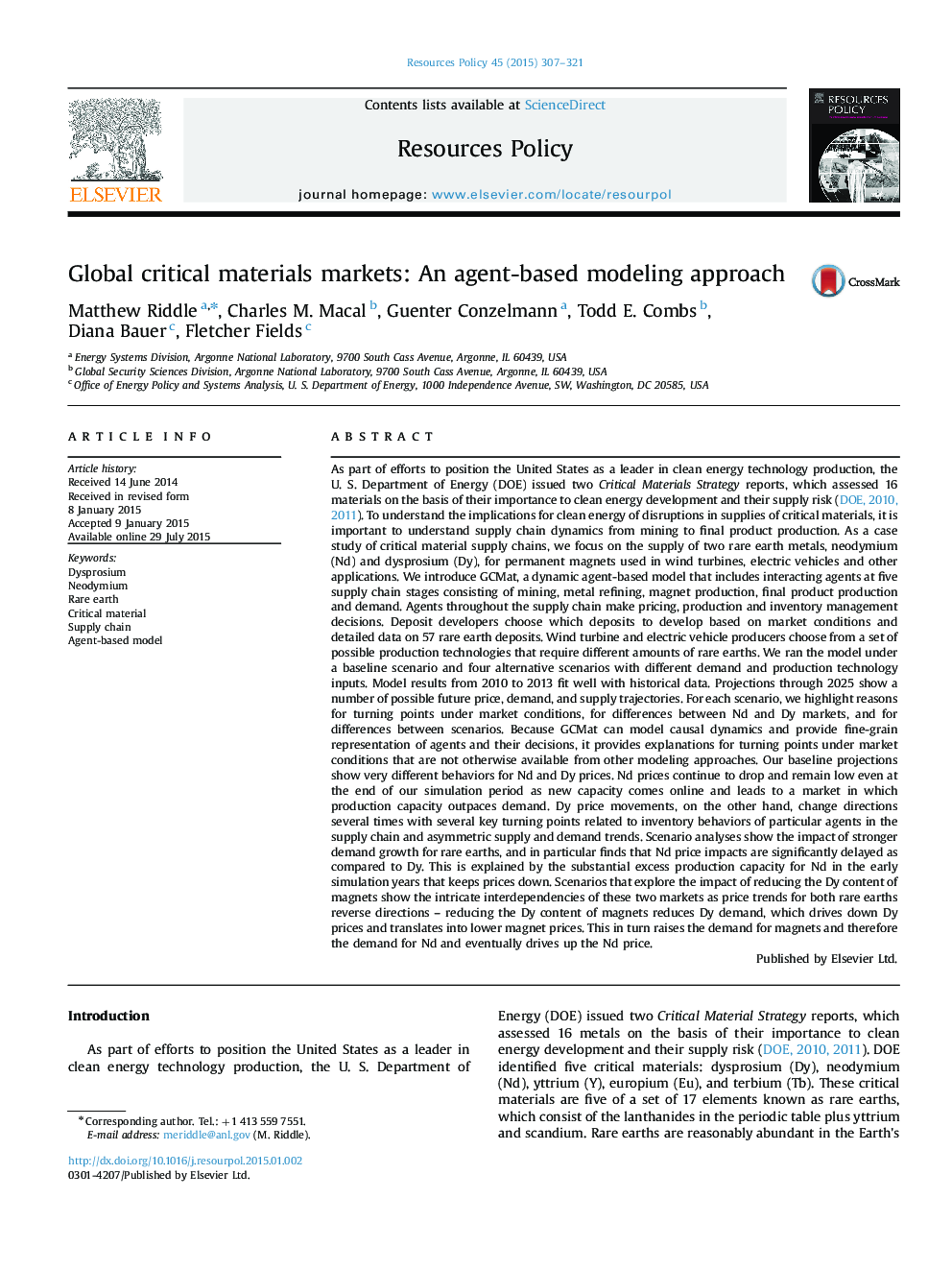| کد مقاله | کد نشریه | سال انتشار | مقاله انگلیسی | نسخه تمام متن |
|---|---|---|---|---|
| 985912 | 1480757 | 2015 | 15 صفحه PDF | دانلود رایگان |
عنوان انگلیسی مقاله ISI
Global critical materials markets: An agent-based modeling approach
ترجمه فارسی عنوان
بازارهای مواد مهم جهانی: یک مدل سازی مبتنی بر عامل
دانلود مقاله + سفارش ترجمه
دانلود مقاله ISI انگلیسی
رایگان برای ایرانیان
کلمات کلیدی
دیسپروزیم، نئودیمیم، زمین نادر، مواد انتقادی، زنجیره تامین، مدل مبتنی بر عامل،
موضوعات مرتبط
مهندسی و علوم پایه
علوم زمین و سیارات
زمین شناسی اقتصادی
چکیده انگلیسی
As part of efforts to position the United States as a leader in clean energy technology production, the U. S. Department of Energy (DOE) issued two Critical Materials Strategy reports, which assessed 16 materials on the basis of their importance to clean energy development and their supply risk (DOE, 2010, 2011). To understand the implications for clean energy of disruptions in supplies of critical materials, it is important to understand supply chain dynamics from mining to final product production. As a case study of critical material supply chains, we focus on the supply of two rare earth metals, neodymium (Nd) and dysprosium (Dy), for permanent magnets used in wind turbines, electric vehicles and other applications. We introduce GCMat, a dynamic agent-based model that includes interacting agents at five supply chain stages consisting of mining, metal refining, magnet production, final product production and demand. Agents throughout the supply chain make pricing, production and inventory management decisions. Deposit developers choose which deposits to develop based on market conditions and detailed data on 57 rare earth deposits. Wind turbine and electric vehicle producers choose from a set of possible production technologies that require different amounts of rare earths. We ran the model under a baseline scenario and four alternative scenarios with different demand and production technology inputs. Model results from 2010 to 2013 fit well with historical data. Projections through 2025 show a number of possible future price, demand, and supply trajectories. For each scenario, we highlight reasons for turning points under market conditions, for differences between Nd and Dy markets, and for differences between scenarios. Because GCMat can model causal dynamics and provide fine-grain representation of agents and their decisions, it provides explanations for turning points under market conditions that are not otherwise available from other modeling approaches. Our baseline projections show very different behaviors for Nd and Dy prices. Nd prices continue to drop and remain low even at the end of our simulation period as new capacity comes online and leads to a market in which production capacity outpaces demand. Dy price movements, on the other hand, change directions several times with several key turning points related to inventory behaviors of particular agents in the supply chain and asymmetric supply and demand trends. Scenario analyses show the impact of stronger demand growth for rare earths, and in particular finds that Nd price impacts are significantly delayed as compared to Dy. This is explained by the substantial excess production capacity for Nd in the early simulation years that keeps prices down. Scenarios that explore the impact of reducing the Dy content of magnets show the intricate interdependencies of these two markets as price trends for both rare earths reverse directions - reducing the Dy content of magnets reduces Dy demand, which drives down Dy prices and translates into lower magnet prices. This in turn raises the demand for magnets and therefore the demand for Nd and eventually drives up the Nd price.
ناشر
Database: Elsevier - ScienceDirect (ساینس دایرکت)
Journal: Resources Policy - Volume 45, September 2015, Pages 307-321
Journal: Resources Policy - Volume 45, September 2015, Pages 307-321
نویسندگان
Matthew Riddle, Charles M. Macal, Guenter Conzelmann, Todd E. Combs, Diana Bauer, Fletcher Fields,
